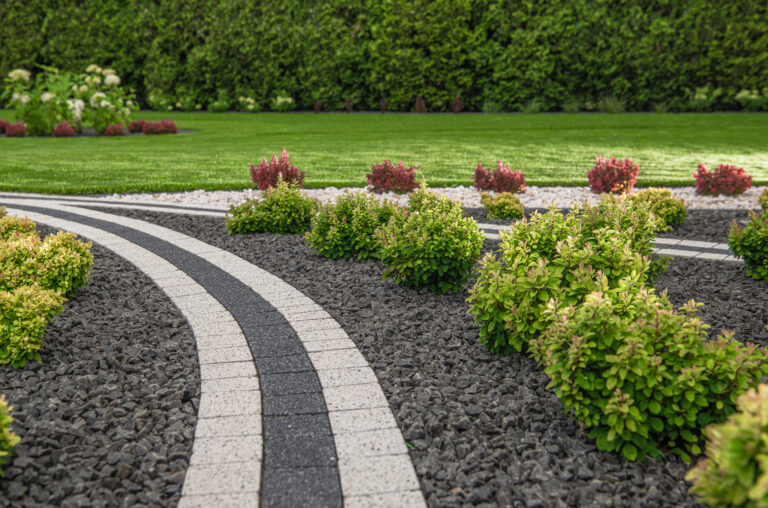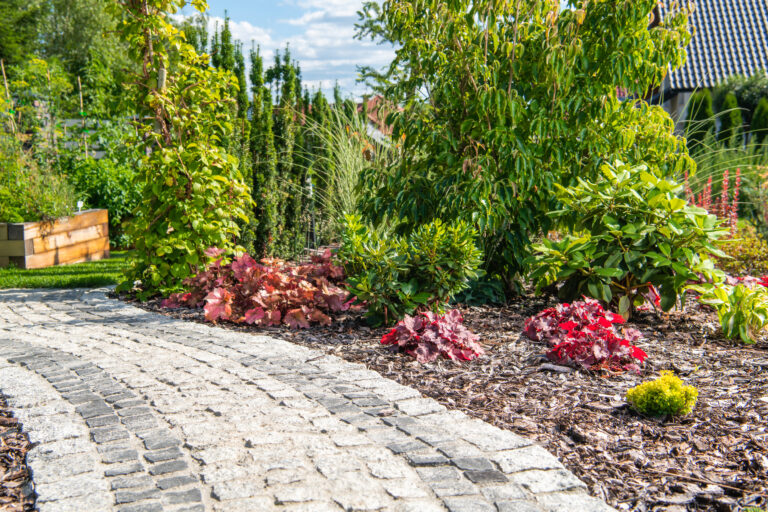Table of Contents
Landscaping rocks are a versatile and aesthetically pleasing option for enhancing your home’s exterior. They offer various functionalities, from creating beautiful garden beds to serving as durable pathways. Here’s an in-depth look at the different types, sizes, and colors of landscaping rocks to consider for your home landscaping projects.
1) Types of Landscaping Rocks
a) River Rocks
- Description: River rocks are smooth, rounded stones naturally polished by water flow over time. They are often used to create a natural look in gardens and landscaping designs. Their smooth texture and rounded shape provide a calming, organic aesthetic.
- Uses: Ideal for garden beds, decorative borders, pathways, and water features like ponds and fountains. They can also be used in dry creek beds to direct water drainage.
- Color: Available in a variety of colors including white, grey, blue, green, and red, which blend seamlessly with natural surroundings. Their diverse color palette can complement a variety of garden styles.
- Size: Often 3/4 inch to 2 inches or larger, ideal for garden beds and water features. Their larger size helps them stay in place, even in flowing water.

b) Lava Rocks
- Description: These rocks are formed from volcanic activity and are characterized by their porous, lightweight structure. Their porous nature allows them to retain heat and moisture, making them suitable for specific landscaping applications.
- Uses: Commonly used as mulch to retain soil moisture, for pathways, and around fire pits due to their ability to withstand high temperatures. They can also be used in xeriscaping to reduce water usage.
- Color: Typically found in red, black, and brown, adding a bold and dramatic touch to landscapes. Their unique texture and color make them stand out in any garden setting.
- Size: Usually between 1 inch to 2 inches in size, used for mulch and decorative purposes. Their lightweight nature makes them easy to handle and spread.
c) Crushed Stone
- Description: Made from larger rocks that have been mechanically crushed into smaller, angular pieces. Crushed stone provides a rugged, durable option that is excellent for high-traffic areas.
- Uses: Perfect for driveways, walkways, and drainage areas because of their excellent drainage properties and stability. They are also used as a base material for pavers.
- Color: Usually comes in shades of grey and white, but can sometimes be found in mixed colors. This makes it a versatile choice for different landscaping themes.
- Size: Available in various sizes from 1/4 inch to 2 inches, used for everything from driveways to drainage systems. The angular shapes lock together well, providing a stable surface.

d) Pea Gravel
- Description: Small, smooth, rounded stones that resemble peas in size and shape. Pea gravel provides a soft, natural look and is comfortable to walk on.
- Uses: Versatile for use in walkways, patios, playground areas, and as a decorative ground cover. It’s also used in flower beds to retain moisture and control weeds.
- Color: Typically found in earthy tones such as brown, grey, white, and sometimes translucent hues. These colors can create a warm, inviting atmosphere in any garden.
- Size: Typically ranges from 1/8 inch to 3/8 inch in size, making it suitable for pathways and patios. Its small size makes it easy to spread and maintain.
e) Flagstone
- Description: Flat, slab-like stones that are easy to stack and arrange. Flagstone offers a classic, timeless look and can be used to create sophisticated outdoor spaces.
- Uses: Ideal for creating patios, stepping stones, garden paths, and even retaining walls. They can be laid out in patterns or used to create random, natural-looking paths.
- Color: Available in various colors including red, blue, grey, and tan, allowing for creative and visually appealing designs. The varied colors and shapes make each flagstone installation unique.
- Size: Varies widely but typically 1 inch to 3 inches thick, ideal for patios and stepping stones. Their flat shape makes them easy to stack and arrange in patterns.
f) Cobblestones
- Description: Large, rounded or square stones often associated with old-world charm. Cobblestones provide a historic, rustic appeal and are highly durable.
- Uses: Perfect for driveways, garden borders, and as accents in garden beds. They can also be used to create retaining walls or decorative features.
- Color: Typically grey or brown, but can be found in mixed colors for a more eclectic look. Their varied sizes and shapes add character and texture to any landscape.
- Size: Ranging from 4 inches to 8 inches, perfect for driveways and garden edging. Their larger size and weight make them excellent for heavy-duty applications.

2) Benefits of Using Landscaping Rocks
- Low Maintenance: Unlike organic mulch, rocks do not decompose and require less frequent replacement. They also help in weed control, reducing the need for herbicides.
- Durability: Landscaping rocks are highly durable and can withstand harsh weather conditions, making them a long-lasting solution for your garden.
- Aesthetic Appeal: Rocks can enhance the visual appeal of your garden by adding texture, color, and structure. They can be used to create focal points, borders, and pathways that stand out.
- Functional Use: Rocks improve drainage, prevent soil erosion, and can be used to stabilize slopes. They also provide a clean and dry surface for outdoor activities.
3) Tips for Choosing the Right Landscaping Rocks
- Purpose: Identify the primary purpose of the rocks in your landscaping design. Whether for decorative, functional, or both, choosing the right type will ensure optimal performance and aesthetic appeal.
- Style: Match the rock type and color to the overall style and color scheme of your home and garden. Neutral tones can create a cohesive look, while bold colors can highlight specific areas.
- Size: Larger rocks like cobblestones are excellent for borders and accents, while smaller rocks like pea gravel are perfect for paths and mulching.
- Maintenance: Consider the maintenance requirements. Smaller rocks may require more frequent weed control, whereas larger rocks might need occasional repositioning.
4) Conclusion
Landscaping rocks are a versatile and attractive option for enhancing your home’s outdoor spaces. With various types, sizes, and colors available, you can create a landscape that is not only beautiful but also functional and low-maintenance. Whether you’re looking to design a serene garden path, a bold decorative feature, or a practical solution for drainage and erosion control, landscaping rocks provide a durable and aesthetically pleasing choice. By carefully selecting the right rocks for your specific needs and style, you can transform your yard into a stunning and welcoming environment. Investing in landscaping rocks can lead to a long-lasting, beautiful, and efficient outdoor space that enhances your home’s curb appeal and overall value. If you’d like to explore options about repurposing landscape rocks, then read our blog Repurposing Landscape Rocks: 7 Cool Ways to Reuse Stones. For more detailed information and tailored advice, visit our page on Rock Installation. For support on your next rock installation project, please feel free to reach out through our contact form, and our team will be happy to help.



